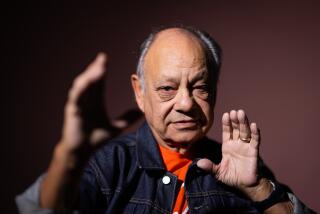ART REVIEW : ‘Chicano Codices’ Has a Social Identity Crisis
Good intentions run amok in “The Chicano Codices: Encountering Art in the Americas,” a visually animated group exhibition at Cal State Northridge that transforms laudable goals into ineffective cliches.
Organized for the Mexican Museum in San Francisco by Marcos Sanchez-Tranquilino and sponsored by the Lila Wallace-Reader’s Digest Fund with support from the Arco Foundation, “The Chicano Codices” is the first of a four-part series designed to alter our view of art in the Americas. This installment means to explore contemporary Chicano identity.
The title refers to the ancient picture books that conveyed the religious myths, social laws and cultural practices of the Mayans, Mixtecs and Aztecs. Most of these remarkable documents were burned by European colonials as they propagated Christianity and scientific rationalism. The few that remain have been renamed after the Europeans who “discovered” them. Bequeathed to museums and libraries, they are now preserved as curious emblems of extinct civilizations.
To symbolically counteract this appropriation, displacement and neutralization of indigenous culture in the Americas, each piece in “Chicano Codices” bears the name of the artist who made it: “Codex Gronk,” “Codex East Los Streetscapers” (David Botello and Wayne Healy), “Codex Spain: Mexico and Me” (Manuel “Spain” Rodriguez) and codices by Celia Munoz, Carlos Fresquez, Deliah Montoya, Marcos Raya and Barbara Carrasco. Yet, the individuality of these works tragically suggests that it is no longer possible for a single codex to speak for all members of a unified society.
A justified attempt to counteract five centuries of exploitation, domination and oppression, “The Chicano Codices” lacks verve, vitality and conviction. Instead, it merely repeats standard conceptions about the contemporary relationship between art and social identity.
As objects of art, the modern codices represent nothing more--and nothing less--than the deep-seated opinions and heartfelt experiences of individual personalities. Titling these highly subjective and sometimes extremely personal paintings, sculptures and assemblages after authoritative manuscripts, which once embodied widely shared laws and social codes, erroneously suggests that an eradicated tradition can be instantaneously remade, whenever an artist enters the studio and invokes the past.
Chicano art often strives to represent knowledge shared by a community, but the individualism represented in these codices would seem to be at cross-purposes with that aspiration. Emphatic individualism is a modern trait, embodied in much 20th-Century European art; usually, though, it has proven to be a poor substitute for the cohesive qualities of religion and myth, social history and political education.
The show has the feel of corporate-sponsored culture, of art fitted into safe categories to flatter prejudices and reduce complex issues to visual “sound bites”--to snappy, superficial phrases that grab your attention yet steer your thinking away from the big picture.
None of the 27 artists would seem to pretend that a single work or exhibition can compensate for the violence and genocide that followed in Columbus’ wake, wiping out entire cultures and mutilating the lives of indigenous peoples. Wisely, the show intends only to begin to give voice to some of those whose cultural heritages have been irreparably altered--if not eradicated--by modern European culture.
But many of the works resemble last-minute, slap-dash efforts. Raoul De La Sota’s scrapbook pierced with plastic knives, Amalia Mesa-Bains’ mishmash of photographs and dried flowers and Patricia Rodriguez’s lamp-lit boxes appear to have been executed merely to meet minimal requirements of the exhibition’s theme.
Likewise, Charles Bojorquez’s fake graffiti on a fake ruin, Alfred J. Quiroz’s wooden zoot-suiters and Lawrence M. Yanez’s kitschy knickknacks don’t seem to satisfy deeply felt needs. The overall impression is of a curatorial directive followed for its own sake and motions dutifully gone through.
Although “The Chicano Codices” undoubtedly springs from meaningful social experiences, which are all the more poignant because they are otherwise denied by dominant American society, these works cannot bypass the fact that they inhabit a sterile, white-walled art gallery. Here, they sadly fall flat because they fail to adequately address their context and its history.
* Cal State University, Northridge, 18111 Nordhoff St., (818) 885-2226, through Saturday.. The show is scheduled to reopen Nov. 18 at Plaza de la Raza.
More to Read
The biggest entertainment stories
Get our big stories about Hollywood, film, television, music, arts, culture and more right in your inbox as soon as they publish.
You may occasionally receive promotional content from the Los Angeles Times.










